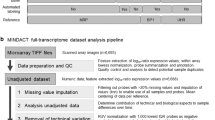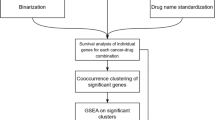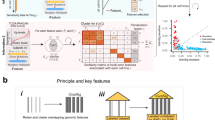Abstract
Scientific advances in the field of genetics and gene-expression profiling have revolutionized the concept of patient-tailored treatment. Analysis of differential gene-expression patterns across thousands of biological samples in a single experiment (as opposed to hundreds to thousands of experiments measuring the expression of one gene at a time), and extrapolation of these data to answer clinically pertinent questions such as those relating to tumor metastatic potential, can help define the best therapeutic regimens for particular patient subgroups. The use of microarrays provides a powerful technology, allowing in-depth analysis of gene-expression profiles. Currently, microarray technology is in a transition phase whereby scientific information is beginning to guide clinical practice decisions. Before microarrays qualify as a useful clinical tool, however, they must demonstrate reliability and reproducibility. The high-throughput nature of microarray experiments imposes numerous limitations, which apply to simple issues such as sample acquisition and data mining, to more controversial issues that relate to the methods of biostatistical analysis required to analyze the enormous quantities of data obtained. Methods for validating proposed gene-expression profiles and those for improving trial designs represent some of the recommendations that have been suggested. This Review focuses on the limitations of microarray analysis that are continuously being recognized, and discusses how these limitations are being addressed.
Key Points
-
Gene-expression microarrays are tools that can be used to simultaneously measure the level of gene expression of all genes within a cell
-
Recent advances in technology and science are propelling microarray-based tests into the forefront of medicine
-
In the last 5 years, numerous gene-expression profiles predicting prognosis and response to specific therapies for several malignancies have been reported
-
Current limitations in the technology as well as in the biostatistical methods of analysis of the large quantities of data generated from microarray tests predispose the results to misinterpretation
-
Standardization of protocols and validation of current profiles will have to ensure that gene-expression profiles are reliable and reproducible, and therefore ready for clinical implementation
This is a preview of subscription content, access via your institution
Access options
Subscribe to this journal
Receive 12 print issues and online access
$209.00 per year
only $17.42 per issue
Buy this article
- Purchase on Springer Link
- Instant access to full article PDF
Prices may be subject to local taxes which are calculated during checkout


Similar content being viewed by others
References
Simon R et al. (2002) Design of studies using DNA microarrays. Genet Epidemiol 23: 21–36
Brazma A et al. (2001) Minimum information about a microarray experiment (MIAME)-toward standards for microarray data. Nat Genet 29: 365–371
Schena M et al. (1995) Quantitative monitoring of gene expression patterns with a complementary DNA microarray. Science 270: 467–470
Hughes TR et al. (2001) Expression profiling using microarrays fabricated by an ink-jet oligonucleotide synthesizer. Nat Biotechnol 19: 342–347
Lipshutz RJ et al. (1999) High density synthetic oligonucleotide arrays. Nat Genet 21: 20–24
Bertucci F et al. (1999) Sensitivity issues in DNA array-based expression measurements and performance of nylon microarrays for small samples. Hum Mol Genet 8: 1715–1722
Van de Goor TA (2005) A history of DNA microarrays. Pharm Discovery 5: 42–45
DeRisi J et al. (1996) Use of a cDNA microarray to analyse gene expression patterns in human cancer. Nat Genet 14: 457–460
Gulmann C et al. (2006) Array-based proteomics: mapping of protein circuitries for diagnostics, prognostics, and therapy guidance in cancer. J Pathol 208: 595–606
Lockhart DJ and Winzeler EA (2000) Genomics, gene expression and DNA arrays. Nature 405: 827–836
Chen CN et al. (2005) Gene expression profile predicts patient survival of gastric cancer after surgical resection. J Clin Oncol 23: 7286–7295
Lu J et al. (2005) MicroRNA expression profiles classify human cancers. Nature 435: 834–838
Meltzer PS (2005) Cancer genomics: small RNAs with big impacts. Nature 435: 745–746
Alizadeh AA et al. (2001) Towards a novel classification of human malignancies based on gene expression patterns. J Pathol 195: 41–52
Simon R et al. (2003) Pitfalls in the use of DNA microarray data for diagnostic and prognostic classification. J Natl Cancer Inst 95: 14–18
Knudsen S (2002) A Biologist's Guide to Analysis of DNA Microarray Data. New York: John Wiley & Sons
Eisen MB et al. (1998) Cluster analysis and display of genome-wide expression patterns. Proc Natl Acad Sci USA 95: 14863–14868
Chang HY et al. (2004) Gene expression signature of fibroblast serum response predicts human cancer progression: similarities between tumors and wounds. PLoS Biol 2: E7
Chang HY et al. (2005) Robustness, scalability, and integration of a wound-response gene expression signature in predicting breast cancer survival. Proc Natl Acad Sci USA 102: 3738–3743
Perou CM et al. (2000) Molecular portraits of human breast tumours. Nature 406: 747–752
van 't Veer LJ et al. (2002) Gene expression profiling predicts clinical outcome of breast cancer. Nature 415: 530–536
van de Vijver MJ et al. (2002) A gene-expression signature as a predictor of survival in breast cancer. N Engl J Med 347: 1999–2009
Nevins JR et al. (2003) Towards integrated clinico-genomic models for personalized medicine: combining gene expression signatures and clinical factors in breast cancer outcomes prediction. Hum Mol Genet 12: R153–R157
Van 't Veer LJ and De Jong D (2002) The microarray way to tailored cancer treatment. Nat Med 8: 13–14
Miller LD et al. (2002) Optimal gene expression analysis by microarrays. Cancer Cell 2: 353–361
Tu IP et al. (2004) A method for detecting and correcting feature misidentification on expression microarrays. BMC Genomics 5: 64
Forster T et al. (2003) Experiments using microarray technology: limitations and standard operating procedures. J Endocrinol 178: 195–204
Perez EA et al. (2004) Improving patient care through molecular diagnostics. Semin Oncol 31: 14–20
Paik S et al. (2005) Technology insight: application of molecular techniques to formalin-fixed paraffin-embedded tissues from breast cancer. Nat Clin Pract Oncol 2: 246–254
Brown I et al. (2003) From peas to “chips” - the new millennium of molecular biology: a primer for the surgeon. World J Surg Oncol 1: 21
Ramaswamy S and Golub TR (2002) DNA microarrays in clinical oncology. J Clin Oncol 20: 1932–1941
Russo G et al. (2003) Advantages and limitations of microarray technology in human cancer. Oncogene 22: 6497–6507
Pusztai L and Hess KR (2004) Clinical trial design for microarray predictive marker discovery and assessment. Ann Oncol 15: 1731–1737
Michiels S et al. (2005) Prediction of cancer outcome with microarrays: a multiple random validation strategy. Lancet 365: 488–492
Jornsten R et al. (2005) DNA microarray data imputation and significance analysis of differential expression. Bioinformatics 21: 4155–4161
Ouyang M et al. (2004) Gaussian mixture clustering and imputation of microarray data. Bioinformatics 20: 917–923
Oba S et al. (2003) A Bayesian missing value estimation method for gene expression profile data. Bioinformatics 19: 2088–2096
Ioannidis JP et al. (2003) Genetic associations in large versus small studies: an empirical assessment. Lancet 361: 567–571
Simon R (2004) When is a genomic classifier ready for prime time? Nat Clin Pract Oncol 1: 4–5
Ntzani EE and Ioannidis JP (2003) Predictive ability of DNA microarrays for cancer outcomes and correlates: an empirical assessment. Lancet 362: 1439–1444
Paik S et al. (2004) A multigene assay to predict recurrence of tamoxifen-treated, node-negative breast cancer. N Engl J Med 351: 2817–2826
Wang Y et al. (2005) Gene expression profiles to predict distant metastasis of lymph-node-negative primary breast cancer. Lancet 365: 671–679
Schaner ME et al. (2003) Gene expression patterns in ovarian carcinomas. Mol Biol Cell 14: 4376–4386
Eschrich S et al. (2005) Molecular staging for survival prediction of colorectal cancer patients. J Clin Oncol 23: 3526–3535
Yeoh EJ et al. (2002) Classification, subtype discovery, and prediction of outcome in pediatric acute lymphoblastic leukemia by gene expression profiling. Cancer Cell 1: 133–143
Ross DT et al. (2000) Systematic variation in gene expression patterns in human cancer cell lines. Nat Genet 24: 227–235
Alizadeh AA et al. (2000) Distinct types of diffuse large B-cell lymphoma identified by gene expression profiling. Nature 403: 503–511
Lapointe J et al. (2004) Gene expression profiling identifies clinically relevant subtypes of prostate cancer. Proc Natl Acad Sci USA 101: 811–816
Yu YP et al. (2004) Gene expression alterations in prostate cancer predicting tumor aggression and preceding development of malignancy. J Clin Oncol 22: 2790–2799
Garber ME et al. (2001) Diversity of gene expression in adenocarcinoma of the lung. Proc Natl Acad Sci USA 98: 13784–13789
Beer DG et al. (2002) Gene expression profiles predict survival of patients with lung adenocarcinoma. Nat Med 8: 816–824
Buckhaults P et al. (2003) Identifying tumor origin using a gene expression-based classification map. Cancer Res 63: 4144–4149
Bittner M et al. (2000) Molecular classification of cutaneous malignant melanoma by gene expression profiling. Nature 406: 536–540
Ebert BL and Golub TR (2004) Genomic approaches to hematologic malignancies. Blood 104: 923–932
Armstrong SA et al. (2003) Inhibition of FLT3 in MLL: validation of a therapeutic target identified by gene expression based classification. Cancer Cell 3: 173–183
Lossos IS et al. (2003) HGAL is a novel interleukin-4-inducible gene that strongly predicts survival in diffuse large B-cell lymphoma. Blood 101: 433–440
Lossos IS et al. (2001) Expression of a single gene, BCL-6, strongly predicts survival in patients with diffuse large B-cell lymphoma. Blood 98: 945–951
Lossos IS et al. (2004) Prediction of survival in diffuse large-B-cell lymphoma based on the expression of six genes. N Engl J Med 350: 1828–1837
Etzioni R et al. (1998) Asymptomatic incidence and duration of prostate cancer. Am J Epidemiol 148: 775–785
Kan T et al. (2004) Prediction of lymph node metastasis with use of artificial neural networks based on gene expression profiles in esophageal squamous cell carcinoma. Ann Surg Oncol 11: 1070–1078
Tamoto E et al. (2004) Gene expression profile changes correlated with tumor progression and lymph node metastasis in esophageal cancer. Clin Cancer Res 10: 3629–3638
Pawitan Y et al. (2005) Gene expression profiling spares early breast cancer patients from adjuvant therapy: derived and validated in two population-based cohorts. Breast Cancer Res 7: R953–R964
Cronin M et al. (2004) Measurement of gene expression in archival paraffin-embedded tissues: development and performance of a 92-gene reverse transcriptase-polymerase chain reaction assay. Am J Pathol 164: 35–42
Esteva FJ et al. (2005) Prognostic role of a multigene reverse transcriptase-PCR assay in patients with node-negative breast cancer not receiving adjuvant systemic therapy. Clin Cancer Res 11: 3315–3319
Ball CA et al. (2002) A guide to microarray experiments-an open letter to the scientific journals. Lancet 360: 1019
Golub TR et al. (1999) Molecular classification of cancer: class discovery and class prediction by gene expression monitoring. Science 286: 531–537
McShane LM et al. (2005) REporting recommendations for tumour MARKer prognostic studies (REMARK). Nat Clin Pract Oncol 2: 416–422
National Center for Biotechnology Information [http://www.ncbi.nlm.nih.gov]
Acknowledgements
We would like to thank L Wessel for advice and critical reading of the manuscript. We thank R Kerkhoven for his artwork for Figure 2.
Author information
Authors and Affiliations
Corresponding author
Ethics declarations
Competing interests
The authors declare no competing financial interests.
Rights and permissions
About this article
Cite this article
Abdullah-Sayani, A., Bueno-de-Mesquita, J. & van de Vijver, M. Technology Insight: tuning into the genetic orchestra using microarrays—limitations of DNA microarrays in clinical practice. Nat Rev Clin Oncol 3, 501–516 (2006). https://doi.org/10.1038/ncponc0587
Received:
Accepted:
Issue Date:
DOI: https://doi.org/10.1038/ncponc0587
This article is cited by
-
Distinct prostate cancer-related mRNA cargo in extracellular vesicle subsets from prostate cell lines
BMC Cancer (2017)
-
Molecular profiling currently offers no more than tumour morphology and basic immunohistochemistry
Breast Cancer Research (2010)
-
Histological and molecular types of breast cancer: is there a unifying taxonomy?
Nature Reviews Clinical Oncology (2009)
-
Using the information embedded in the testing sample to break the limits caused by the small sample size in microarray-based classification
BMC Bioinformatics (2008)
-
MiMiR – an integrated platform for microarray data sharing, mining and analysis
BMC Bioinformatics (2008)



